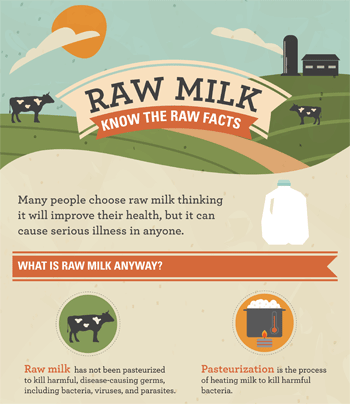Raw (Unpasteurized) Milk
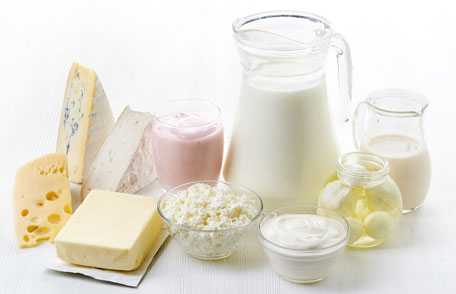 Raw milk can contain harmful germs, such as bacteria, viruses, and parasites, which can make you very sick or possibly kill you. If you’re thinking about drinking raw milk because you believe it has health benefits, consider other options.
Raw milk can contain harmful germs, such as bacteria, viruses, and parasites, which can make you very sick or possibly kill you. If you’re thinking about drinking raw milk because you believe it has health benefits, consider other options.
Developing a healthy lifestyle involves many decisions. Some people think about adding raw milk to their diet. Raw milk is milk that has not been pasteurized (heated to a specific temperature for a set amount of time) to kill harmful germs that may be in it. Because these germs usually don’t change the look, taste, or smell of milk, pasteurization is the best way to make sure your milk is safe.
Questions and answers about raw milk
Can raw milk hurt me or my family?
Yes. Raw milk is unpasteurized milk from any animal. Raw milk can carry harmful germs that can make you very sick or kill you, including Campylobacter, Cryptosporidium, E. coli, Listeria, and Salmonella.
Getting sick from raw milk can mean many days of diarrhea, stomach cramping, and vomiting. Less commonly, it can mean kidney failure, paralysis, chronic disorders, and even death.
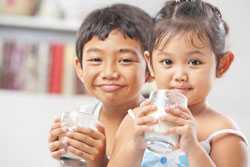
Infants and young children, older adults, pregnant women, and people with weakened immune systems have a greater chance of getting sick if they drink raw milk that contains harmful germs.
Who has a greater chance of getting sick from drinking raw milk or eating products made from it, such as cheese, ice cream, and yogurt?
The chance of getting sick from drinking raw milk is greater for infants and young children, older adults, pregnant women, and people with weakened immune systems–like people with cancer, an organ transplant, or HIV—than it is for healthy older children and adults. However, healthy people of any age can get very sick or even die if they drink raw milk contaminated with harmful germs.
What can I do to lower my chances of getting sick from milk and milk products?
- Choose pasteurized milk and milk products. Look for the word “pasteurized” on the label. If in doubt, don’t buy it!
- Keep milk and milk products refrigerated at 40°F or colder, and throw away any expired milk or milk products to lower your chance of getting sick.
- If you eat soft cheeses, make sure they are made from pasteurized milk. Soft cheeses include queso fresco, queso blanco, panela (queso panela), brie, Camembert, blue-veined, and feta.
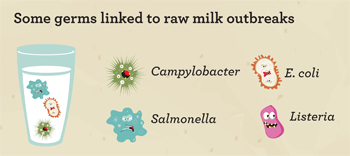
Harmful germs found in raw milk can make people sick. These germs include bacteria, parasites, and viruses, such as Campylobacter, Cryptosporidium, E. coli, Listeria, and Salmonella.
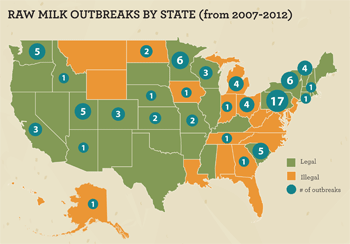
Outbreaks linked to raw milk are more common in states where raw milk sales are legal.
Aren’t raw or natural foods better than processed foods?
Many people believe that foods with little or no processing are better for their health. However, some types of processing are needed to protect our health. We make raw meat, poultry, and fish safe to eat by cooking these foods. We make milk safe by heating it just long enough to kill disease-causing germs when it’s pasteurized. Most nutrients remain in milk even after it is pasteurized.
Is raw milk a good source of beneficial bacteria?
No. Raw milk contains bacteria, and some of them can be harmful. So, if you’re thinking about drinking raw milk because you believe it is a good source of beneficial bacteria, you need to know that you may instead get sick from drinking it. Pasteurized fermented foods, such as yogurt and kefir, contain bacteria that are safe to eat.
Can I still get a disease from raw milk and raw milk products if the cows, goats, or sheep are healthy, clean, and grass-fed, or if the dairy is especially careful and clean when collecting the milk?
Yes. Following good hygiene during milking can reduce the risk of milk contamination but not eliminate it. Small numbers of bacteria can multiply and grow in milk from the time it is collected until the time a person drinks it. If the milk is not pasteurized to kill germs, those who drink it can become ill. Methods for collecting milk have improved over the years but cannot be relied on alone to be sure milk is safe to drink.
Raw milk from “certified, “organic,” or “local” dairies is not guaranteed to be safe. Only pasteurization can make milk safe to drink. There are many local, small farms that offer pasteurized organic milk and products made from it.
My dairy farmer performs laboratory tests for bacteria in raw milk, so isn’t it safe?
Negative tests do not guarantee that raw milk is safe to drink. Milk that is safe one day may not be safe the next day. Also, low levels of contamination are not always detected by tests. People have become very sick from drinking raw milk that came from farms that regularly tested their milk for bacteria and whose owners indicated they were sure that their milk was safe.
Questions and answers about raw milk-related outbreaks
How many outbreaks have been related to raw milk?
Reported outbreaks represent the tip of the iceberg. Most foodborne illnesses are not part of a recognized outbreak, and for every outbreak and every illness reported, many others occur.
Where do most raw milk-related outbreaks happen?
Raw milk-related outbreaks are more common in states that allow the legal sale of raw milk for people to drink than in states that do not allow its sale. In addition, raw milk sales in one state can lead to outbreaks in neighboring states.
Who is most affected by raw milk outbreaks?
A large number of raw milk outbreaks involve children. At least one child younger than 5 was involved in 59% of the raw milk outbreaks reported to CDC from 2007 through 2012. In these outbreaks, 38% of the illnesses caused by Salmonella and 28% caused by Shiga toxin-producing E. coli, which can cause kidney failure and death, were among children aged 1–4.
Protect yourself and your loved ones. Avoid raw milk – it’s just not worth the risk.
Keep Learning:
- Page last reviewed: February 22, 2017
- Page last updated: February 22, 2017
- Content source:
- National Center for Emerging and Zoonotic Infectious Diseases, Division of Foodborne, Waterborne, and Environmental Diseases
- Page maintained by: Office of the Associate Director for Communication, Digital Media Branch, Division of Public Affairs




 ShareCompartir
ShareCompartir
